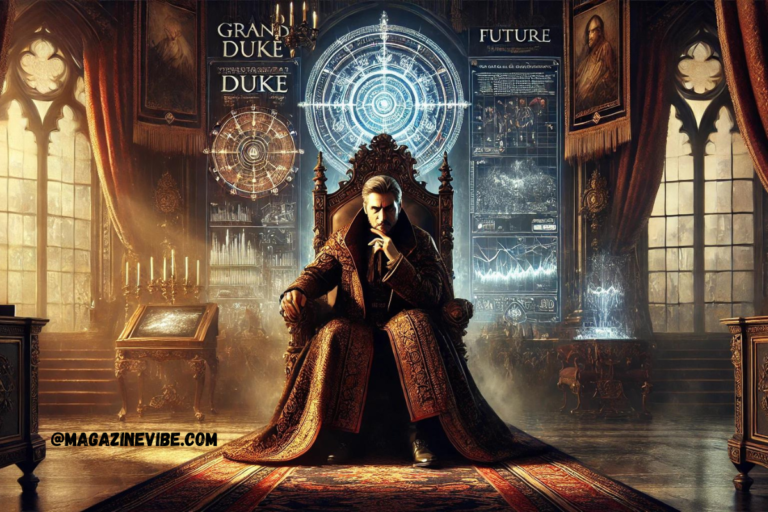Introduction
“I Saw the Future with the Killer Grand Duke” is a captivating story that dives deep into a blend of fantasy, romance, and suspense. It follows the thrilling journey of Gabriella Nashert, a woman who finds herself intertwined with a mysterious and powerful Grand Duke. This novel keeps readers on the edge of their seats, and learning about key plot points in advance can significantly enhance the reading experience.
Spoilers are essential in this context; they help set expectations and can make the narrative even more enjoyable. Knowing crucial twists or the ultimate resolution can add a layer of anticipation as readers piece together how the story unfolds. For fans and new readers alike, spoilers serve as a roadmap that guides their experience through the complex world and character dynamics presented in the novel. This article aims to provide an insightful spoiler-filled guide to better appreciate the depth and creativity woven into “I Saw the Future with the Killer Grand Duke.”
Plot Overview
Introduction to the Main Characters: Gabriella Nashert and the Grand Duke Ernst
Gabriella Nashert, the central figure in “I Saw the Future with the Killer Grand Duke,” is not your typical heroine. Originally, she is portrayed as a villainess with a notorious reputation, which adds a unique twist to her character. Gabriella’s journey begins anew when she reincarnates, bringing with her the memories of her previous life, which she uses to navigate the dangers and intrigues of her new world.
The Grand Duke Ernst, another pivotal character, is shrouded in mystery and power. Known for his strategic mind and formidable presence, Ernst plays a crucial role in both the political and personal spheres of the story. His interactions with Gabriella are complex, marked by conflict, intrigue, and an underlying tension that hints at deeper emotions.
Summary of the Initial Plot: Gabriella’s Reincarnation and Marriage Strategy
The story kicks off with a dramatic start when Gabriella finds herself reincarnated. Armed with the knowledge of her past life, she devises a plan to avoid the tragic end she met previously. Her strategy involves entering into a marriage of convenience with none other than the Grand Duke Ernst. This alliance is not just a means for survival but also a tactical move to gain a foothold in the treacherous political landscape that led to her demise in her past life.
This marriage, based on mutual benefit and guarded secrets, sets the stage for a series of events that unravel throughout the novel. Gabriella’s unique position as someone who knows the future but must navigate her present circumstances adds a layer of suspense and strategy to the plot, making every interaction and decision critical.
Character Analysis
Detailed Examination of Gabriella Nashert: Her Traits and Evolution Throughout the Story
Gabriella Nashert begins her journey as a notorious villainess, known for her cunning and manipulative traits, which originally position her as an antagonist in the eyes of the reader. However, as the story progresses and Gabriella reincarnates, we see a significant transformation in her character. Armed with the knowledge of her previous life’s downfall, she adopts a more strategic and diplomatic approach to navigate her new life.
Gabriella’s evolution is marked by her growing empathy and understanding of the people around her, shifting from a self-centered villainess to a more rounded, complex protagonist. Her ability to adapt and strategically plan her moves showcases her intelligence and resilience. Despite her past as a villain, Gabriella’s character growth involves her becoming more aware of her moral choices, making decisions that often put others before her own interests.
Insights into the Grand Duke: His Complexities and Motivations
The Grand Duke Ernst is a multifaceted character enveloped in mystery and authority. His initial portrayal as a distant and powerful leader gradually unfolds to reveal a character driven by much more than mere desire for power. Ernst’s motivations are deeply intertwined with his past experiences and the secrets he holds, which influence his decisions and relationships, particularly with Gabriella.
Ernst’s complexity is highlighted by his strategic mindset, which is both a strength and a source of internal conflict. He is portrayed as a character who must balance his harsh exterior with his underlying vulnerabilities. His interactions with Gabriella bring these complexities to the forefront, as he often finds himself torn between his duties as a Grand Duke and his personal feelings.
The dynamic between Gabriella and Ernst evolves from strategic alliance to a more nuanced relationship, reflecting the intricacies of their characters. Ernst’s motivations are not just about maintaining power but also about protecting those he cares for, which becomes increasingly apparent as his character is further developed. This evolution showcases a leader who is not only strategic and powerful but also capable of change and depth of emotion.
Key Themes and Motifs
Analysis of Major Themes such as Betrayal, Love, and Destiny
“I Saw the Future with the Killer Grand Duke” is rich with themes that drive the narrative forward and give depth to its characters.
- Betrayal: The theme of betrayal runs deep and impacts the core of the plot. Gabriella’s previous life ended in betrayal, which shapes her approach in her new life. The fear and consequences of betrayal influence her relationships, particularly with Ernst, as she navigates trust and deception in a world where alliances are fragile.
- Love: Love in this narrative is complex and layered. It’s not just about romance but also about the love between friends, family, and even between rivals. The relationship between Gabriella and Ernst evolves from mutual benefit to genuine affection, showcasing how love can grow in the most unexpected circumstances. This theme is crucial in humanizing the characters and making their struggles relatable.
- Destiny: Destiny is a powerful theme, especially given the novel’s focus on reincarnation. Characters grapple with their fate and question whether they can alter their predestined paths. This struggle highlights the tension between free will and destiny, making the reader ponder whether the characters are merely acting out a predetermined script or actively shaping their futures.
Discussion on the Motifs of Reincarnation and Revenge
- Reincarnation: Reincarnation is a key motif that sets the foundation of the story. Gabriella’s ability to remember her past life and use that knowledge to influence her current circumstances introduces questions about identity, change, and continuity. It raises philosophical questions about the self and what it means to start over with the consciousness of another life.
- Revenge: Revenge motivates many of the characters’ actions, particularly in the early parts of the story. It’s intertwined with the motif of reincarnation, as past grievances carry over into new lives, influencing decisions and interactions. This motif explores the cyclical nature of revenge and its impact on a person’s ability to find peace and happiness.
Spoiler Section: Plot Twists and Climax
Discussion of Major Plot Twists Without Revealing Specifics
“I Saw the Future with the Killer Grand Duke” masterfully employs several plot twists that serve to continuously reshape the reader’s understanding of the narrative and the characters’ motivations. These twists are pivotal in keeping the storyline intriguing and unpredictable. For instance, the revelation of hidden alliances and past betrayals redefines relationships and loyalties, pushing the narrative into new directions. Another significant twist involves the uncovering of secret identities and true intentions, which challenge the protagonist’s plans and force a recalibration of her strategies.
Each plot twist is crafted to not only surprise the reader but also to deepen the complexity of the story, making each revelation feel like a piece of a larger puzzle being placed. This technique ensures that the narrative maintains a gripping pace and that the stakes remain high throughout the novel.
Effects of These Twists on the Narrative and Character Development
The impact of these plot twists on character development is profound. Characters are forced to confront their weaknesses, secrets, and fears. For Gabriella, each twist tests her resilience and adaptability, showcasing her growth from a mere player in the game to its master. The Grand Duke Ernst, on the other hand, finds his seemingly unshakeable resolve and loyalties challenged, revealing vulnerabilities that add layers to his character.
Narratively, the plot twists serve to escalate the tension and drama, driving the story towards its climax. They enrich the world-building and enhance the themes of betrayal and redemption. As characters react and adjust to these revelations, the reader sees a dynamic world where actions have serious repercussions, and nothing is as simple as it seems.
The climax, built upon these twists, culminates in a convergence of all the story’s elements—character arcs, thematic explorations, and narrative trajectories—delivering a satisfying resolution that resonates emotionally with the readers. It ties together the threads of love, betrayal, and destiny, leaving the audience reflecting on the journey long after the final page is turned.
Reader’s Reflection
How the Spoilers Align with the Story’s Themes
In “I Saw the Future with the Killer Grand Duke,” spoilers play a crucial role in aligning with and enhancing the story’s themes. By knowing key plot twists in advance, readers can appreciate the depth of the themes of destiny, betrayal, and redemption as they see them unfolding. Spoilers can act as a lens, focusing attention on the subtler hints and foreshadowing that might otherwise go unnoticed. For example, knowing that a character will betray another can heighten the tension in their interactions, making the reader more attuned to the nuances of dialogue and description that hint at the impending betrayal.
Additionally, spoilers related to the theme of destiny can deepen the reader’s engagement with the philosophical questions the story raises. Knowing the outcomes can prompt readers to think critically about the choices characters make and whether those choices can truly alter their fates or if they are merely illusions of choice in a predetermined story.
Personal Reflection on the Impact of Knowing Spoilers Ahead of Reading
Knowing spoilers ahead of reading “I Saw the Future with the Killer Grand Duke” can significantly impact a reader’s experience. For some, it enhances the reading process by setting clear expectations and allowing them to focus on how the story gets to those known outcomes rather than what those outcomes are. This can make the journey more enjoyable, as they’re not just reading to discover “what happens,” but also to understand “how and why it happens,” which can be particularly gratifying in a story rich with complex characters and intricate plot developments.
For others, spoilers might diminish the element of surprise but increase the emotional and intellectual engagement with the text. They might find themselves more deeply analyzing the characters’ development and motivations, as well as the writer’s craft in constructing the narrative. This kind of reading can lead to a more thoughtful and appreciative experience, even if it sacrifices the initial thrill of the unknown.
Conclusion
“I Saw the Future with the Killer Grand Duke” presents a tapestry of intricate plots, deep characters, and significant themes that resonate with a wide audience. The story adeptly mixes elements of fantasy, romance, and drama, offering readers a rich narrative that challenges perceptions of destiny and power. Through its thoughtful use of spoilers, the novel invites readers to delve deeper into its complex world, enhancing the reading experience by aligning these reveals with the overarching themes of betrayal, redemption, and the cyclical nature of fate.
This novel not only entertains but also provides a space for reflection on the impact of knowing crucial plot points beforehand, demonstrating how spoilers can serve to enrich one’s understanding of the narrative and its characters. As readers journey through the twists and turns of Gabriella and Ernst’s lives, they find themselves more engaged, pondering the delicate balance between fate and free will. “I Saw the Future with the Killer Grand Duke” thus stands out as a compelling read that offers both suspense and insightful commentary on human nature.
FAQs
Q1: What is the main plot of “I Saw the Future with the Killer Grand Duke”?
The story revolves around Gabriella Nashert, who reincarnates with memories of her previous life and strategizes to avoid her past fate by marrying the Grand Duke Ernst. The narrative explores themes of betrayal, destiny, and redemption as she navigates her new life in a complex world filled with political intrigue and personal challenges.
Q2: Who are the main characters in the novel?
The primary characters include Gabriella Nashert, initially portrayed as a villainess who reincarnates to change her fate, and the Grand Duke Ernst, a powerful and enigmatic figure deeply involved in the realm’s politics and Gabriella’s life.
Q3: How does the theme of reincarnation affect the storyline?
Reincarnation is a central motif that affects the storyline by providing Gabriella with foreknowledge of potential events, which she uses to make strategic decisions aimed at altering her fate. This theme also introduces philosophical questions about destiny and free will.
Q4: Are there any notable plot twists in the story?
Yes, the story features several plot twists that reshape relationships and character motivations, adding depth and intrigue to the narrative. These twists often revolve around revelations of past betrayals, secret identities, and unexpected alliances.
Q5: What makes “I Saw the Future with the Killer Grand Duke” unique?
This novel stands out due to its intricate blend of fantasy and romance, set against a backdrop of political intrigue. The use of reincarnation as a plot device allows for a unique exploration of themes like destiny and self-determination, making it not just a tale of love and betrayal but also a reflective look at the choices that define us.
Q6: How do spoilers enhance the reading experience for this novel?
Spoilers can enhance the reading experience by allowing readers to focus on how the story unfolds rather than merely what happens. Knowing key plot elements in advance lets readers appreciate the setup and execution of narrative twists, deepening their understanding of character development and thematic depth.


